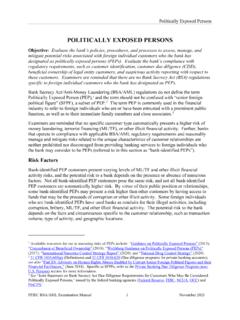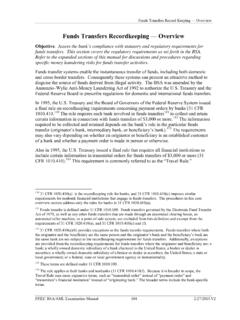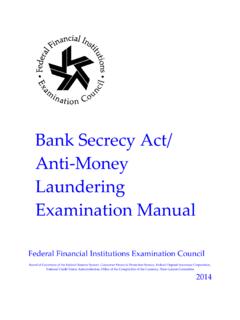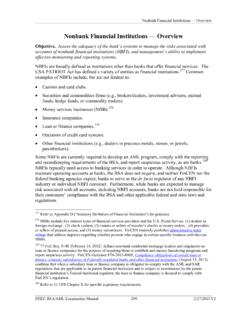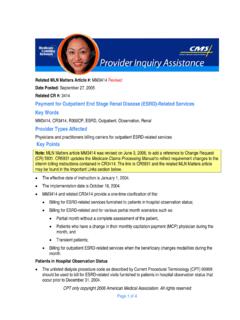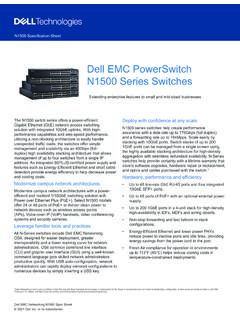Transcription of Suspicious Activity Reporting — Overview
1 Suspicious Activity Reporting Overview FFIEC BSA/AML Examination Manual 60 2/27 Suspicious Activity Reporting Overview Objective. Assess the bank s policies, procedures, and processes, and overall compliance with statutory and regulatory requirements for monitoring, detecting, and Reporting Suspicious activities. Suspicious Activity Reporting forms the cornerstone of the BSA Reporting system. It is critical to the United States ability to utilize financial information to combat terrorism, terrorist financing, money laundering, and other financial crimes.
2 Examiners and banks should recognize that the quality of SAR content is critical to the adequacy and effectiveness of the Suspicious Activity Reporting system. Within this system, FinCEN and the federal banking agencies recognize that, as a practical matter, it is not possible for a bank to detect and report all potentially illicit transactions that flow through the bank. Examiners should focus on evaluating a bank s policies, procedures, and processes to identify, evaluate, and report susp icious Activity . However, as part of the examination process, examiners should review individual SAR filing decisions to determine the effectiveness of the bank s Suspicious Activity identification, evaluation, and Reporting process.
3 Banks, bank holding companies, and their subsidiaries are required by federal regulations53 to file a SAR with respect to: Criminal violations involving insider abuse in any amount. Criminal violations aggregating $5,000 or more when a suspect can be identified. Criminal violations aggregating $25,000 or more regardless of a potential suspect. Transactions conducted or attempted by, at, or through the bank (or an affiliate) andaggregating $5,000 or more, if the bank or affiliate knows, suspects, or has reason tosuspect that the transaction: May involve potential money laundering or other illegal Activity ( , terrorismfinancing).
4 54 Is designed to evade the BSA or its implementing Has no business or apparent lawful purpose or is not the type of transaction that theparticular customer would normally be expected to engage in, and the bank knows ofno reasonable explanation for the transaction after examining the available facts,including the background and possible purpose of the transaction includes a deposit; a withdrawal; a transfer between accounts; an exchange of currency; an extension of credit; a purchase or sale of any stock, bond, certificate of deposit, 53 Refer to 12 CFR , (k), (f), and (f) (Board of Governors of the Federal Reserve System) (Federal Reserve); 12 CFR 353 (Federal Deposit Insurance Corporation)(FDIC); 12 CFR 748 (National Credit Union Administration)(NCUA); 12 CFR and 12 CFR (Office of the Comptroller of the Currency)(OCC); and 31 CFR (FinCEN).
5 54 FinCEN issued guidance identifying certain BSA expectations for banks offering services to marijuana-related businesses, including expectations for filing SARs, FIN -2014-G001, February 14, 2014. 55 Refer to Appendix G ( Structuring ) for additional guidance. Suspicious Activity Reporting Overview FFIEC BSA/AML Examination Manual 61 2/27 or other monetary instrument or investment security; or any other payment, transfer, or delivery by, through, or to a bank. Safe Harbor for Banks From Civil Liability for Suspicious Activity Reporting Federal law (31 USC 5318(g)(3)) provides protection from civil liability for all reports of Suspicious transactions made to appropriate authorities, including supporting documentation, regardless of whether such reports are filed pursuant to the SAR instructions.
6 Specifically, the law provides that a bank and its directors, officers, employees, and agents that make a disclosure to the appropriate authorities of any possible violation of law or regulation, including a disclosure in connection with the preparation of SARs, shall not be liable to any person under any law or regulation of the United States, any constitution, law, or regulation of any State or political subdivision of any State, or under any contract or other legally enforceable agreement (including any arbitration agreement), for such disclosure or for any failure to provide notice of such disclosure to the person who is the subject of such disclosure or any other person identified in the disclosure.
7 The safe harbor applies to SARs filed within the required Reporting thresholds as well as to SARs filed voluntarily on any Activity below the Systems to Identify, Research, and Report Suspicious Activity Suspicious Activity monitoring and Reporting are critical internal controls. Proper monitoring and Reporting processes are essential to ensuring that the bank has an adequate and effective BSA compliance program. Appropriate policies, procedures, and processes should be in place to monitor and identify unusual Activity . The sophistication of monitoring systems should be dictated by the bank s risk profile, with particular emphasis on the composition of higher-risk products, services, customers, entities, and geographies.
8 The bank should ensure adequate staff is assigned to the identification, research, and Reporting of Suspicious activities, taking into account the bank s overall risk profile and the volume of transactions. Monitoring systems typically include employee identification or referrals, transaction-based (manual) systems, surveillance (automated) systems, or any combination of these. Generally, effective Suspicious Activity monitoring and Reporting systems include five key components (refer to Appendix S Key Suspicious Activity Monitoring Components ).
9 The components, listed below, are interdependent, and an effective Suspicious Activity monitoring and Reporting process should include successful implementation of each component. Breakdowns in any one or more of these components may adversely affect SAR Reporting and BSA compliance. The five key components to an effective monitoring and Reporting system are: 56 The agencies incorporated the statutory expansion of the safe harbor by cross-referencing section 5318(g) in their SAR regulations. The OCC and FinCEN amended their SAR regulations to make clear that the safe harbor also applies to a disclosure by a bank made jointly with another financial institution for purposes of filing a joint SAR (see 12 CFR (l) and 31 CFR (e)), respectively.
10 Suspicious Activity Reporting Overview FFIEC BSA/AML Examination Manual 62 2/27 Identification or alert of unusual Activity (which may include: employee identification,law enforcement inquiries, other referrals, and transaction and surveillance monitoringsystem output). Managing alerts. SAR decision making. SAR completion and filing. Monitoring and SAR filing on continuing components are present in banks of all sizes. However, the structure and formality of the components may vary. Larger banks typically have greater differentiation and distinction between functions, and may devote entire departments to the completion of each component.
